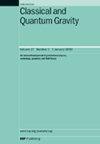B-spline based arm length estimation algorithm for space-borne gravitational wave detection
IF 3.7
3区 物理与天体物理
Q2 ASTRONOMY & ASTROPHYSICS
引用次数: 0
Abstract
Data preprocessing is an essential step in space-borne gravitational wave detection, aimed at calibrating the data while suppressing noise. Time delay interferometry represents the primary technique for eliminating laser frequency noise, relying on precise arm length information. In this study, we combined pseudo-random noise ranging and Doppler measurements from TianQin’s data to create an observation equation and established an arm length model using a cubic B-spline function. To ensure accurate representation of the arm length and relative velocity, we employed quadruple-precision orbit information to simulate the observation data and determine reasonable spline node distances through fitting analysis. By utilizing the weighted least squares algorithm, we could estimate arm length information with millimeter-level accuracy. We investigated the contributions of the spline model’s smoothing function and additional Doppler measurement information to arm length estimation accuracy while analyzing the impact of weighting coefficients on the estimation results. Finally, we compared the accuracy of our proposed algorithm with that of the existing Kalman filter algorithm.基于b样条的星载引力波探测臂长估计算法
数据预处理是星载引力波探测的重要环节,其目的是在校正数据的同时抑制噪声。时间延迟干涉是消除激光频率噪声的主要技术,它依赖于精确的臂长信息。本研究将拟随机噪声测距与多普勒测量相结合,建立了观测方程,并利用三次b样条函数建立了臂长模型。为了保证臂长和相对速度的准确表示,我们采用四倍精度的轨道信息对观测数据进行模拟,通过拟合分析确定合理的样条节点距离。利用加权最小二乘算法,我们可以估计出毫米级精度的臂长信息。研究了样条模型的平滑函数和附加多普勒测量信息对臂长估计精度的贡献,同时分析了加权系数对估计结果的影响。最后,将本文算法与现有卡尔曼滤波算法的精度进行了比较。
本文章由计算机程序翻译,如有差异,请以英文原文为准。
求助全文
约1分钟内获得全文
求助全文
来源期刊

Classical and Quantum Gravity
物理-天文与天体物理
CiteScore
7.00
自引率
8.60%
发文量
301
审稿时长
2-4 weeks
期刊介绍:
Classical and Quantum Gravity is an established journal for physicists, mathematicians and cosmologists in the fields of gravitation and the theory of spacetime. The journal is now the acknowledged world leader in classical relativity and all areas of quantum gravity.
 求助内容:
求助内容: 应助结果提醒方式:
应助结果提醒方式:


